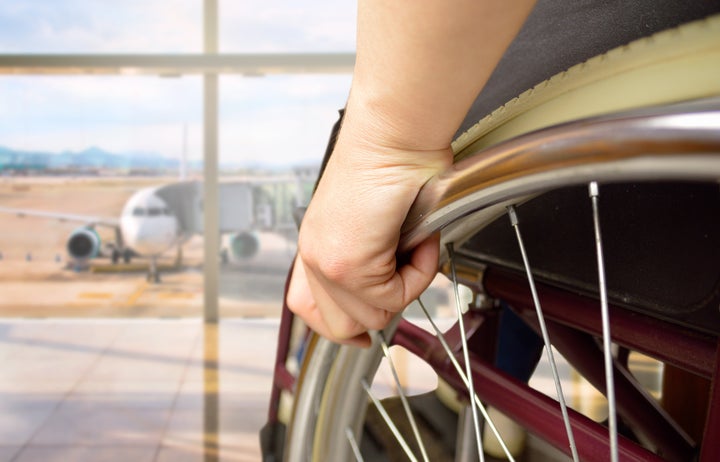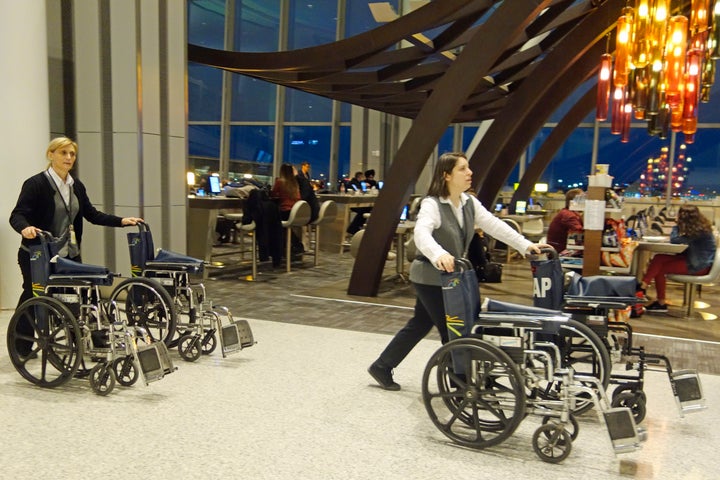
This story is the third in HuffPost Canada’s UNFRIENDLY SKIES, a three-part series that looks at the impact of rapid airline industry changes on Canadian passengers.

Pat Danforth remembers a time when flying with a disability was somewhat more difficult than it is today.
In one incident that has stuck with her through the years, Danforth ― who has been using a wheelchair since a spinal cord injury in 1970 ― was informed by staff at the now-defunct Canadian Airlines that she would need accompaniment if she wanted to fly.
“I ended up talking to the pilot,” the long-time disability rights advocate said. “I had never been more embarrassed. They asked me about my toilet habits. What happens if I had to pee. They asked what would happen if the plane crashed, and they didn’t like my answer which was, well, I would probably die.”
Watch: Canada’s new air passenger rules could shaft some travelers. Story continues below.
Since then, Danforth, who lives in Victoria, B.C., says she has seen “incremental” improvement in conditions for disabled passengers, but also some steps backwards. Airline seats have gotten smaller and aisles have gotten narrower.
On the plus side, some larger aircraft now have larger bathrooms that can fit airline-issued on-board wheelchairs. But even so, having staff help you to the bathroom in your wheelchair can be embarrassing, and not every disabled person can manage it.
“Normally I stop drinking liquids the day before so that I don’t have to use the washroom on board the flight,” she said, adding that she typically lets herself drink something only when her flight is an hour from landing.
Dehydration is a risky practice that, for many disabled people, is the only reasonable way to be able to fly. And it’s one of the core reasons that some people are upset about the country’s new air passenger bill of rights. They say that, in effect, it limits how far disabled people can fly.
Under the new body of regulations, many of which came into force on July 15, 2019, airlines will be able to keep passengers on the tarmac for up to three hours during a take-off delay, plus an additional 45 minutes if the airline believes takeoff is imminent.
And while Transport Canada says that’s more or less the global standard ― in the U.S. it’s three hours for domestic flights and four hours for international ― some disability rights advocates say it amounts to a shortening of the distance they can fly.
“A lot of individuals who acquire a disability either because of age or accident aren’t aware of (their rights) and often feel grateful when things that should be provided are provided. And when things go wrong they think there’s nothing you can do.”
- Disabled persons rights activist Pat Danforth
That’s because Canadian air passengers had previously benefited from an unofficial rule that limited tarmac waits to 90 minutes at some airlines. Though it was voluntary, it was written into many airlines’ tariffs (the contract between airline and passenger), and the limit was sometimes enforced by the Canadian Transportation Agency, which issued fines for violations.
Bob Brown, an Ottawa-based disability rights advocate, estimates that the new rule will shave 1,500 km to 2,000 km off the maximum distance he can safely travel in an aircraft.
“That’s mileage I could have done, except I can’t plan for it if I can (be made to) sit for three hours and some-odd minutes on the tarmac,” he said in an interview with HuffPost Canada.
‘The wrong way’
Brown and air passenger rights advocate Gabor Lukacs have filed a joint lawsuit against the Canadian Transportation Agency, asking the Federal Court of Appeal to hear the case on the ground the new rules violate the Charter of Rights and Freedoms.
Brown says he wants the air passenger rules changed to reflect the 90-minute standard that existed before.
“This regulation was supposed to benefit people. How is this going to benefit people, going the wrong way?”
But the government is standing by its decision to keep the limit at three hours with a potential 45-minute extension. A spokesperson for Transport Minister Marc Garneau noted the previous 90-minute rule didn’t apply to all airlines, and the new rules will mark the first time there is a universal standard for airlines in Canada.

“The three-hour timeframe was chosen based on operational realities and international best practices,” a spokesperson said in an email to HuffPost Canada. “For example, in the United States, air carriers are required to offer the option to disembark after a three hour delay on domestic flights, and a four hour delay on international flights.”
Brown knows he faces an uphill battle, and it’s an open question whether other disabled flyers will join him.
“People with disabilities don’t complain much,” he said. “To actually go to court, it’s expensive. Most people just say, ‘Oh, what the heck.’”
Danforth agrees, noting many disabled people may not even be aware of their rights.
“A lot of individuals who acquire a disability either because of age or accident aren’t aware of (their rights) and often feel grateful when things that should be provided are provided,” she said. “And when things go wrong they think there’s nothing you can do.”
New accessibility rules
But Danforth praises some of the new protections the Canadian Transportation Agency is putting into place for disabled travelers on large airlines, starting next year.
One notable rule is a “one person, one fare” policy, which means airlines won’t be able to charge disabled people extra fare if they occupy more space than a typical passenger. Additionally, if a passenger requires the assistance of another person, that person can fly as an attendant at no charge. There are also provisions that allow for service dogs.
Most of these rules will apply on large airlines and on domestic flights only.
Danforth says Brown’s lawsuit “will help focus the airlines and the Minister of Transportation on what the impact is,” but seems otherwise pleased that, at the very least, there is some sort of industry-wide standard for wait times. Still, if a flight she was on were delayed by three hours, “it would be problematic,” she notes.
She points to one key thing: “You have to be aware of the needs of the passengers.”